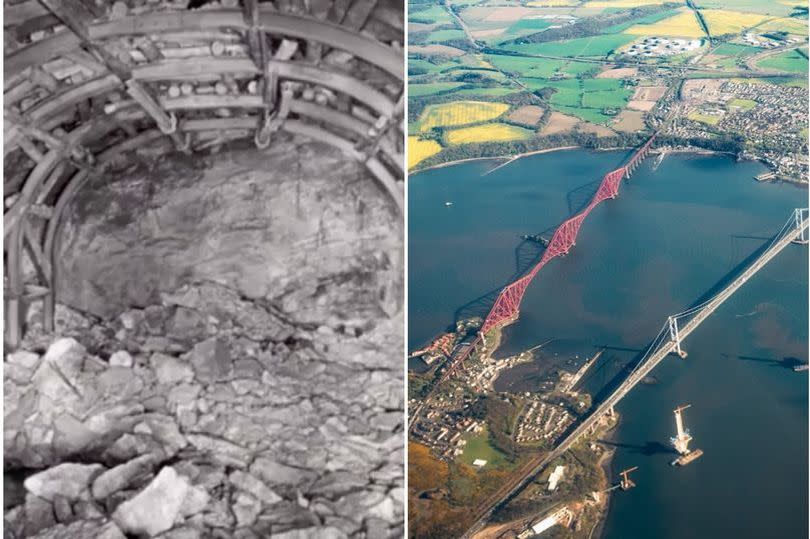Underwater tunnel that let people walk beneath Firth of Forth long before cars could cross water

An amazing underwater tunnel near Edinburgh once allowed people to stroll under the Firth of Forth, long before cars and buses were able to cross the water. This hidden gem, deeply tucked away in the Bo'ness countryside, is an astounding feat of engineering that allowed foot travel between the shores before the iconic road bridge was erected.
According to the experts, it's so well concealed that "you probably wouldn't even know it was there". Before cars and buses were traversing the Forth, miners from the Kinneil and Valleyfield collieries could traverse six-and-a-half kilometres at 1500ft below sea level, with the tunnel linking West Lothian and Fife.
After 18 months of gruelling labour, this remarkable link was formally unveiled in 1964. While there was definitely a buzz and an air of novelty about being able to walk between the regions, there was also a crucially practical motivation behind this ambitious venture, reports Edinburgh Live.
The coal preparation plant at Valleyfield, just west of Dunfermline, was becoming outdated and potentially perilous. With an urgent necessity to transport coal to the more state-of-the-art facility at Kinneil, an innovative solution came into play.
The grand idea? Craft a brand new passage that would directly link the two collieries. Especially when considering the projected development cost for the Valleyfield plant circled around £1million, while the estimated price tag for a revolutionary underwater link was just about half of that.
Brian Murray, who dedicated decades to the mining industry and now volunteers at the National Mining Museum in Newtongrange, said: "You have to remember there were already tunnels at both Valleyfield and Kinneil. This was just about connecting them which was still a massive challenge.

"I do remember there being quite a bit of talk between the miners at the time about walking under the Forth. But there are a number of mining tunnels in the area with interesting stories people might not know about – including one at Inveresk Hill."
Coal production commenced at Valleyfield in 1908 and at Kinneil in 1955, but it wasn't until the early 1960s that plans to link the two sites were conceived.
The visionary behind this colossal undertaking was engineer Alistair Moore, who, despite his youth, was chosen to spearhead the project. Reflecting on the experience during a 2017 interview with BBC Radio Scotland, Moore said: "At 31, I was 'just a wee laddie' when the works started."
The project's ambition was evident from the outset, as workers began the arduous task of chiselling and digging through solid rock. The engineering feat required the tunnels from the north and south to align perfectly and maintain the same level to facilitate the movement of carts.
Selecting the precise locations for the drivages was critical, ensuring they provided adequate ventilation and conformed to stringent safety regulations. Once the plans were in place, it was all about gathering the necessary materials and workforce to undertake such an ambitious project.
A dedicated team of 27 men toiled for 18 months until the first connection was established in 1962. This milestone was achieved when a drivage in the Lochgelly Splint Seam from Valleyfield reached the Seaward Mine from Kinneil.
At that juncture, the walking distance between the two points was approximately six and a half kilometres. Subsequently, a second link was forged in August 1966, followed by a third two years later.
The Linlithgowshire Journal and Gazette, on Friday, May 8, 1964, proclaimed that "Scottish mining history had been made" when it was officially opened.
They further reported that David Archibald, manager at Kinneil Colliery, and Norman Wallace, manager at Valleyfield, clasped hands to complete the link, with Mr Archibald humorously remarking: "I hope you have plenty of coal for me."
After greeting the two managers, Bo'ness Provost Robert Ross was the first to make his way into the tunnel, saying he was "excited and thrilled" at the honour. A small group started their journey from Kinneil, marking their names as the first to venture the historic trip under the Forth to Valleyfield.
The significant link assured the "preservation of two mining communities", as Kinneil's future seemed grim back then, grappling with flooding and geological problems. But although the tunnel was functioning for over a decade, Valleyfield halted its operations in 1978, not quite living up to the forecast.
Kinneil also had to pull down its shutters a few years later, as the end of the mining industry came to pass, and consequently, the tunnel became obsolete by the early 1980s.
David Bell, National Mining Museum's assistant curator, said that only a faint trace remains of either colliery; including the extraordinary submerged passage. He said: "You probably wouldn't even know it was there now. It may have collapsed under the pressure of gravity, it could be waterlogged.
"It closed in 1982 and that was it, it's obviously not been maintained. But it was a very successful project and quite the feat of engineering to ensure that the tunnels met up."
While this tunnel is no longer in operation, it's a reminder that alongside modern engineering marvels like the Queensferry Crossing, there's also a wealth of history hidden beneath the waves of the Forth.
Don't miss the latest news from around Scotland and beyond. Sign up to our daily newsletter.

 Yahoo News
Yahoo News 
